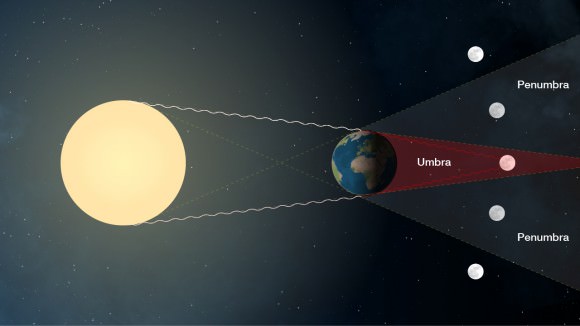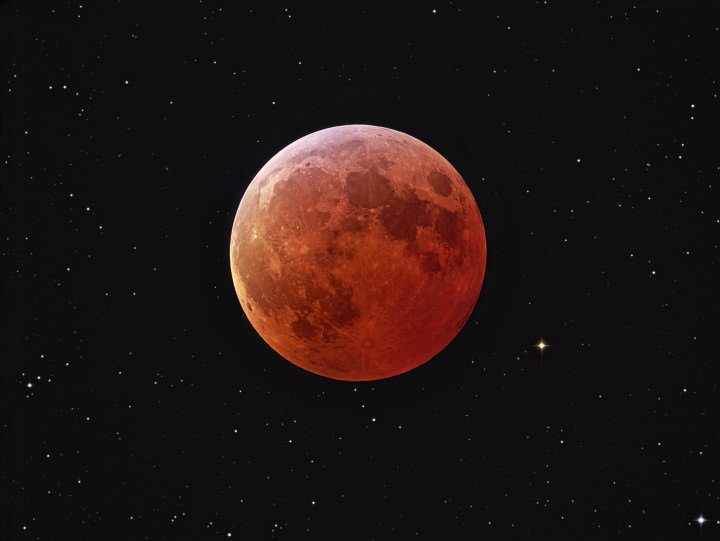On most evenings, the Moon will appear as a bright yellow or white color in the night sky. But on occasion, the Moon can turn a beautiful and dramatic red, coppery color. Naturally, there are a number of superstitions associated with this stellar event. But to modern astronomers, a Red Moon is just another fascinating phenomenon that has a scientific explanation.
Since the earliest days of recorded history, the Moon has been believed to have a powerful influence over human and animal behavior. To the Romans, staring at a full Moon was thought to drive a person crazy – hence the term “lunatic”. Farmers in the past would plant their crops “by the moon”, which meant sowing their seeds in accordance with the Moon’s phases in the hopes of getting a better harvest.
So naturally, when the Moon turned red, people became wary. According to various Biblical passages, a Blood Moon was thought to be a bad omen. But of course, the Moon turns red on a semi-regular basis, and the world has yet to drown in fire. So what really accounts for a “Red Moon?” What causes Earth’s only satellite to turn the color of blood?
Ordinarily, the Moon appears as it does because it is reflecting light from the Sun. But on occasion, it will darken and acquire either a golden, copper, or even rusty-red color.
There are few situations that can cause a red Moon. The most common way to see the Moon turn red is when the Moon is low in the sky, just after moonrise or before it’s about to set below the horizon. Just like the Sun, light from the Moon has to pass through a larger amount of atmosphere when it’s down near the horizon, compared to when it’s overhead.
The Earth’s atmosphere can scatter sunlight, and since moonlight is just scattered sunlight, it can scatter that too. Red light can pass through the atmosphere and not get scattered much, while light at the blue end of the spectrum is more easily scattered. When you see a red moon, you’re seeing the red light that wasn’t scattered, but the blue and green light have been scattered away. That’s why the Moon looks red.
The second reason for a red Moon is if there’s some kind of particle in the air. A forest fire or volcanic eruption can fill the air with tiny particles that partially obscure light from the Sun and Moon. Once again, these particles tend to scatter blue and green light away, while permitting red light to pass through more easily. When you see a red moon, high up in the sky, it’s probably because there’s a large amount of dust in the air.

A third – and dramatic – way to get a red Moon is during a lunar eclipse. This happens when the Moon is full and passes into Earth’s shadow (also known as the umbra), which darkens it. At that point, the Moon is no longer being illuminated by the Sun. However, the red light passing through the Earth’s atmosphere does reach the Moon, and is thus reflected off of it.
For those observing from the ground, the change in color will again be most apparent when the Moon appears low in the night sky, just after moonrise or before it’s about to set below the horizon. Once again, this is because our heavy atmosphere will scatter away the blue/green light and let the red light go straight through.
The reddish light projected on the Moon is much dimmer than the full white sunlight the Moon typically reflects back to us. That’s because the light is indirect and because the red-colored wavelengths are only a part of what makes up the white light from the sun that the Moon usually receives.
In other words, when you see a red Moon, you’re seeing the result of blue and green light that has been scattered away, and the red light remaining.

And that’s the various ways how we get a Red Moon in the night sky. Needless to say, our ancient forebears were a little nervous about this celestial phenomenon occurrence.
For example, Revelations 6:12/13 says that a Red Moon is a sign of the apocalypse: “When he opened the sixth seal, I looked, and behold, there was a great earthquake, and the sun became black as sackcloth, the full moon became like blood, and the stars of the sky fell to the earth as the fig tree sheds its winter fruit when shaken by a gale.”
But rest assured that if you see one, it’s not the end of the world. The Sun and Moon will rise again. And be sure to check out this Weekly Space Hangout, where the April 4th eclipse is discussed:
We have covered lunar eclipses many times on Universe Today, and often explain the red Moon phenomenon. Here’s another good explanation of the science behind a Red Moon, and why the recent series of lunar eclipses in 2014 and 2015 (known as a tetrad) do not mean anything apocalyptic, and here’s another article about how to see a lunar eclipse. Here’s an article that includes a stunning array of images of the Moon during an eclipse in 2014.
Of course, NASA has some great explanations of the red Moon effect during a lunar eclipse. Here’s another one.
You can listen to a very interesting podcast about the formation of the Moon from Astronomy Cast, Episode 17: Where Did the Moon Come From?
Sources: NASA Science: Lunar Eclipse, NASA: Mars Exploration, Discovery News, NASA: Eclipse Website


Your grasp of the physics of light cannot be faulted. Your grasp of logic and reading comprehension, not so much. My suggestion for a revised title: “A Red Moon — probably NOT a sign of the Apocalypse – although if accompanied by earthquakes, blackened Sun and falling stars, all bets are off.”
Actually, his title is just fine. Were this a website devoted to something other than science and fact, I may agree with you. Your suggested title gives an ounce of credibility that a blood moon may in fact precede an apocalypse. As if though an apocalypse is possible. And since it isn’t possible and this website is devoted to science, reason and fact, his title is perfect.
good to know from astronomers, that stars are so far and cannot fall to Earth, I prefer astronomers from Bible explanatores of Universe